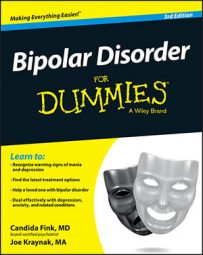The primary treatment for bipolar disorder is medication with the goal of restoring normal brain function. The following classes of medications are often used in treating bipolar disorder and related conditions:
Antimanics: Medications that target mania include lithium; certain anticonvulsants, such as valproate (Depakote); and certain newer or atypical antipsychotics, such as olanzapine (Zyprexa). Antimanics are often referred to as mood stabilizers, even though very few of them — namely, lithium and some of the atypical antipsychotics — reduce symptoms of both mania and depression.
Antidepressants: Medications that target depression include Selective Serotonin Reuptake Inhibitors (SSRIs), such as paroxetine (Paxil) and fluoxetine (Prozac), and bupropion (Wellbutrin). Antidepressants must be used carefully in bipolar depression because they can be less effective or even trigger manic symptoms in some people. Lithium, the anticonvulsant lamotrigine (Lamictal), and certain atypical antipsychotics, such as aripiprazole (Abilify), also have antidepressant effects, typically without the risks of triggering mania.
Antipsychotics: Antipsychotics were originally developed to help treat schizophrenia, but they're often useful in treating psychosis that sometimes accompanies acute mania or depression. Many of the newer antipsychotics are also used to treat acute mania and bipolar depression, and some are used for treatment-resistant unipolar depression, but they're still referred to as antipsychotics.
Maintenance/prevention medications: These are medications that are continued after an acute mood episode to reduce the likelihood that another mood cycle will occur. Lithium is the most common medicine used for this, but certain anticonvulsants such as lamotrigine (Lamictal) and some atypical antipsychotics such as olanzapine (Zyprexa) can be used this way as well.
Antianxiety medications: Antianxiety medications (sometimes called anxiolytics, pronounced ang-zy-oh-lit-ics) include alprazolam (Xanax) and clonazepam (Klonopin). Some medications in this category may also be used as sedatives. Antianxiety medications aren't used to treat the bipolar disorder itself but to help with the commonly co-occurring symptoms of anxiety or agitation.
Sedatives: Because sleeplessness often accompanies mania or depression and may exacerbate it, doctors often prescribe sedatives (sleep aids), such as zolpidem (Ambien), eszopiclone (Lunesta), and zaleplon (Sonata). These aren't used to treat bipolar symptoms, but rather to help manage sleep issues that often affect people with bipolar and that can complicate the illness.
Other treatments, including light therapy, electroconvulsive therapy (ECT), repetitive transcranial magnetic stimulation (rTMS), and deep brain stimulation (DBS), target the biology of the brain. These therapies, like medication, are designed to treat the brain in order to alter thinking, mood, and behavior. Other therapies and self-help strategies, including interpersonal and social rhythm therapy (IPSRT), mindfulness training, and dialectical behavior therapy (DBT), seek to change thinking, mood, and behavior in order to improve brain function.

